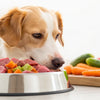Is It Better to Cook Raw Dog Food? A Comprehensive Guide for Pet Owners
- Houndsy
Table of Contents
- Introduction
- Understanding Dog Nutrition
- The Raw Dog Food Diet
- The Cooked Dog Food Diet
- Comparing Raw and Cooked Dog Food
- Integrating Fresh Food into Your Dog's Diet
- The Role of the Houndsy Kibble Dispenser in Your Feeding Routine
- Frequently Asked Questions (FAQs)
- Conclusion
Introduction
Have you ever considered the best diet for your furry friend? As pet owners increasingly focus on nutrition, many of us are left grappling with a burning question: is it better to cook raw dog food? Statistics indicate that nearly 30% of dog owners are experimenting with raw diets, leading to a surge in interest surrounding the health implications of feeding dogs raw versus cooked meals. This leads us to an exploration of the raw versus cooked debate, a topic that can significantly impact our pets' health and well-being.
In this blog post, we will delve into the nuances of raw and cooked dog food, examining the benefits and potential downsides of each option. By the end, you'll gain a clearer understanding of what might best suit your dog’s dietary needs, and you may even reassess your own pet-feeding practices. So, let’s embark on this informative journey, addressing the intricate details that will enable you to make the best choice for your beloved companion.
Understanding Dog Nutrition
Before diving into the specifics of cooked and raw diets, it’s vital to grasp the fundamental principles of dog nutrition. Dogs are omnivores by nature, meaning they can thrive on various food sources. Their ideal diet should include:
- High-quality protein sources: such as meat or fish for muscle development and overall energy.
- Fats: essential fatty acids, vital for skin and coat health.
- Carbohydrates: providing energy and aiding digestive health.
- Vitamins and minerals: necessary for various bodily functions.
When considering whether to feed raw or cooked food, it's essential to ensure that whatever option you choose meets these nutritional criteria.
The Raw Dog Food Diet
The raw dog food diet (often called BARF, for Biologically Appropriate Raw Food) consists primarily of uncooked meat, along with bones, organs, fruits, and vegetables. Advocates for raw feeding believe it mimics a dog's ancestral eating habits and is closer to what wild canines consume. Here are some potential benefits and drawbacks:
Benefits of Raw Dog Food
- Natural Diet: Proponents argue that raw food allows dogs to eat in a more natural manner, which can lead to improved health.
- Improved Digestion: Many dog owners report enhanced digestion and healthier stools when switching to raw diets.
- Less Processed: Raw foods are typically lower in preservatives and chemicals than processed kibble.
Drawbacks of Raw Dog Food
- Pathogen Risks: Raw meat can harbor harmful bacteria like Salmonella and E. coli, posing risks to both dogs and humans handling the food.
- Nutritional Imbalances: If not properly balanced, raw diets can lead to deficiencies, particularly in essential nutrients.
- Safety and Handling Issues: Preparing raw foods often requires stringent hygiene practices to avoid contamination.
It’s clear that while a raw food diet has the allure of being natural and unprocessed, it comes with a set of challenges that pet owners must carefully evaluate.
The Cooked Dog Food Diet
On the other side of the coin is cooked dog food, which typically involves preparing food ingredients through gentle cooking methods. This can include boiling, baking, or even sous-vide cooking. Here are the common benefits and drawbacks:
Benefits of Cooked Dog Food
- Reduced Pathogen Risks: Cooking meat eliminates harmful bacteria, making it safer for dogs and easier for pet owners to handle.
- Easier Digestion: Many dogs find cooked food easier to digest, particularly older dogs or those with sensitive stomachs.
- Tasty Variety: Cooking food can enhance flavors and aromas, potentially making meals more appealing to picky eaters.
Drawbacks of Cooked Dog Food
- Nutrient Loss: Cooking can result in the degradation of some heat-sensitive nutrients; however, gentle cooking methods like sous-vide can help retain more nutrients than other cooking styles.
- Time and Preparation: Preparing cooked food can be time-consuming and often requires knowledge of nutritional balance.
- Cost: High-quality cooked dog food tends to be more expensive than processed kibble.
Ultimately, cooked dog food addresses some of the safety and digestibility concerns associated with raw diets while maintaining many of the health benefits associated with a fresh, minimally processed feeding approach.
Comparing Raw and Cooked Dog Food
When comparing the two, it’s essential to look beyond mere preference and consider the nutritional implications. Let’s explore some key differences:
Nutritional Analysis
- Meat Quality: Raw diets often include raw meats that may not always come from reliable sources. In contrast, cooked options can consist of human-grade ingredients that adhere to strict safety standards.
- Digestibility: Studies suggest that both raw and cooked diets offer high digestibility compared to standard kibble. It is essential to select high-quality food, regardless of whether it is raw or cooked.
- Nutritional Completeness: Cooked dog food brands are often required to meet AAFCO guidelines, ensuring a balanced intake of all necessary nutrients—something that can be more difficult to achieve with raw feeding without careful planning.
Handling and Safety
When feeding raw, diligent food handling is paramount. This means thoroughly cleaning prep surfaces, refrigerating food immediately, and using safe thawing methods. In contrast, cooked dog food generally presents a much lower risk of bacterial contamination, providing peace of mind for pet owners.
Integrating Fresh Food into Your Dog's Diet
Regardless of whether you lean toward cooked or raw food, integrating fresh ingredients into your dog’s diet can provide numerous benefits. Here are some examples of fresh foods you can safely incorporate:
- Vegetables: Cooked carrots, peas, and sweet potatoes add vital fiber and nutrients.
- Fruits: Blueberries and apples can serve as delicious treats.
- Healthy fats: Supplementing with fish oil or incorporating fatty fish like salmon can support skin and coat health.
Always remember to introduce new foods gradually to avoid digestive upset, and consider rotating proteins to provide a broader nutritional base.
The Role of the Houndsy Kibble Dispenser in Your Feeding Routine
Feeding your dog should be an enjoyable and streamlined experience. At Houndsy, our commitment to simplifying pet care is reflected in our flagship product, the Houndsy Kibble Dispenser. With features like perfect portion control and a sleek mid-century modern design, it enhances both the functionality and aesthetics of your feeding routine.
When you consider cooking or preparing fresh ingredients for your dog, the Houndsy Kibble Dispenser can help maintain consistency in meal sizes while keeping your dog’s food fresh and easily accessible. Explore our Houndsy Kibble Dispenser and see how it fits into your feeding routine!
Frequently Asked Questions (FAQs)
Is it better to feed my dog raw or cooked meals?
There is no definitive answer as both raw and cooked diets have their benefits and drawbacks. Your choice should depend on your dog's specific needs, lifestyle, and health conditions.
Can I mix raw and cooked dog food?
Mixing raw and cooked foods can be controversial. Some experts suggest that feeding them together can interfere with digestion. It's best to consult with a veterinarian for tailored advice.
How can I ensure that my dog's diet is nutritionally balanced?
When preparing dog food, whether raw or cooked, it's vital to ensure that meals are balanced and complete. Consider consulting with a veterinary nutritionist to create a tailored diet plan that meets your dog's nutritional needs.
Do I need to worry about feeding my dog raw food during the summer?
Yes, raw food can spoil quickly in warm temperatures. It's essential to maintain safe storage practices and monitor the food closely to avoid potential health risks.
What should I do if my dog refuses to eat their food?
If your dog is not eating, consult with a veterinarian to rule out underlying health issues. You can also consider experimenting with different food types, including cooked meals, to find a suitable option.
Conclusion
Ultimately, the decision between raw and cooked dog food relies on various factors, including your dog's individual health, preferences, and your lifestyle as a pet owner. As always, careful consideration, research, and consultation with a veterinarian can guide you toward the best decision for your furry family member. If you're looking to elevate your dog’s feeding experience while enjoying the confidence of safe and effective food management, consider the Houndsy Kibble Dispenser as a stylish and convenient solution.
Are you ready to enhance your dog’s nutrition with nourishing meals and convenient feeding? Let’s continue the conversation about fresh food diets and how Houndsy can play a role in simplifying and beautifying your daily pet care routine!













